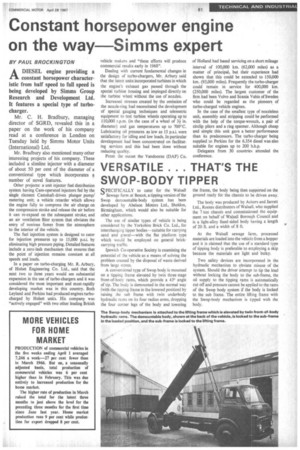Constant horsepower engine on the way Simms expert
Page 63

If you've noticed an error in this article please click here to report it so we can fix it.
BY PAUL BROCKINGTON
ADIESEL engine providing a constant horsepower characteristic from half speed to full speed is being developed by Shunts Group Research and Development Ltd. It features a special type of turbocharger.
Mr. C. H. Bradbury, managing director of SGRD, revealed this in a paper on the work of his company read at a conference in London on Tuesday held by Simms Motor Units (International) Ltd.
Mr. Bradbury also mentioned many other interesting projects of his company. These included a slimline injector with a diameter of about 50 per cent of the diameter of a conventional type which incorporates a number of novel features.
Other projects: a unit injector fuel distribution system having Cam-operated injectors fed by the single clement Camshaft-driven plunger pump/ metering unit; a vehicle retarder which allows the engine fully to compress the air charge on the compression stroke and release the air before it can re-expand on the subsequent stroke; and an air ventilation filter system that obviates the entry of noxious fumes from the atmosphere to the interior of the vehicle.
The fuel injection system is designed to cater for injection pressures up to 15,000 p.s.i. by eliminating high pressure piping. Detailed features include a zero-lash mechanism that ensures that the point of injection remains constant at all speeds and loads.
In a paper on turbo-charging Mr. R. Arbury, of Holset Engineering Co. Ltd., said that the next two to three years would see substantial expansion in the use of turbo-chargers and it was considered the most important and most rapidly developing market was in this country. Both Leyland and Perkins had produced engines turbocharged by Holset units. His company was "actively engaged" with two other leading British vehicle makers and "these efforts will produce commercial results early in 1968".
Dealing with current fundamental changes in the design of turbo-chargers, Mr. Arbury said that the latest units incorporated turbines in which the engine's exhaust gas passed through the special turbine housing and impinged directly on the turbine wheel without the use of nozzles.
Increased stresses created by the omission of the nozzle-ring had necessitated the development of special gauging techniques and telemetric equipment to test turbine wheels operating up to 110,000 r.p.m. (in the case of a wheel of 31 in. diameter) and gas temperatures up to 700°C. Lubricating oil pressures as low as 15 p.s.i. were satisfactory for idling and low loads. In particular development had been concentrated on facilitating services and this had been 'done without reducing quality.
From the outset the Vandoorne (DAF) Co. of Holland had based servicing on a short mileage interval of 100,000 km. (62,000 miles) as a matter of principal, but their experience had shown that this could be extended to 150,000 km. (93,000 miles). Frequently the turbo-charger could remain in service for 400,000 km. (250,000 miles). The largest customer of the firm had been Volvo and Scania Vabis of Sweden who could be regarded as the pioneers of turbo-charged vehicle engines.
In the case of the smallest type of nozzleless unit, assembly and stripping could be performed with the help of the torque-wrench, a pair of circlip pliers and a ring spanner. Although cheap and simple this unit gave a better performance than its predecessors. The turbo-charger being supplied to Perkins for the 6.354 diesel was also suitable for engines up to 200 b.h.p.
Delegates from 30 countries attended the conference.
















































































































































































